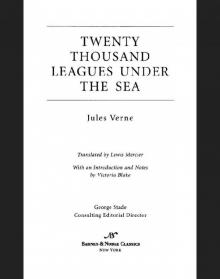- Home
- Jules Verne
Robur-le-conquerant. English Page 7
Robur-le-conquerant. English Read online
Page 7
Chapter VII
ON BOARD THE ALBATROSS
"When will man cease to crawl in the depths to live in the azure andquiet of the sky?"
To this question of Camille Flammarion's the answer is easy. It willbe when the progress of mechanics has enabled us to solve the problemof aviation. And in a few years--as we can foresee--a morepractical utilization of electricity will do much towards thatsolution.
In 1783, before the Montgolfier brothers had built theirfire-balloon, and Charles, the physician, had devised his firstaerostat, a few adventurous spirits had dreamt of the conquest ofspace by mechanical means. The first inventors did not think ofapparatus lighter than air, for that the science of their time didnot allow them to imagine. It was to contrivances heavier than air,to flying machines in imitation of the birds, that they trusted torealize aerial locomotion.
This was exactly what had been done by that madman Icarus, the son ofDaedalus, whose wings, fixed together with wax, had melted as theyapproached the sun.
But without going back to mythological times, without dwelling onArchytas of Tarentum, we find, in the works of Dante of Perugia, ofLeonardo da Vinci and Guidotti, the idea of machines made to movethrough the air. Two centuries and a half afterwards inventors beganto multiply. In 1742 the Marquis de Bacqueville designed a system ofwings, tried it over the Seine, and fell and broke his arm. In 1768Paucton conceived the idea of an apparatus with two screws,suspensive and propulsive. In 1781 Meerwein, the architect of thePrince of Baden, built an orthopteric machine, and protested againstthe tendency of the aerostats which had just been invented. In 1784Launoy and Bienvenu had maneuvered a helicopter worked by springs. In1808 there were the attempts at flight by the Austrian Jacques Degen.In 1810 came the pamphlet by Denian of Nantes, in which theprinciples of "heavier than air" are laid down. From 1811 to 1840came the inventions and researches of Derblinger, Vigual, Sarti,Dubochet, and Cagniard de Latour. In 1842 we have the EnglishmanHenson, with his system of inclined planes and screws worked bysteam. In 1845 came Cossus and his ascensional screws. In 1847 cameCamille Vert and his helicopter made of birds' wings. In 1852 cameLetur with his system of guidable parachutes, whose trial cost himhis life; and in the same year came Michel Loup with his plan ofgliding through the air on four revolving wings. In 1853 cameBeleguic and his aeroplane with the traction screws, Vaussin-Chardanneswith his guidable kite, and George Cauley with his flying machinesdriven by gas. From 1854 to 1863 appeared Joseph Pline with severalpatents for aerial systems. Breant, Carlingford, Le Bris, DuTemple, Bright, whose ascensional screws were left-handed; Smythies,Panafieu, Crosnier, &c. At length, in 1863, thanks to the effortsof Nadar, a society of "heavier than air" was founded in Paris.There the inventors could experiment with the machines, of whichmany were patented. Ponton d'Amecourt and his steam helicopter, LaLandelle and his system of combining screws with inclined planesand parachutes, Louvrie and his aeroscape, Esterno and his mechanicalbird, Groof and his apparatus with wings worked by levers. Theimpetus was given, inventors invented, calculators calculatedall that could render aerial locomotion practicable. Bourcart,Le Bris, Kaufmann, Smyth, Stringfellow, Prigent, Danjard, Pomesand De la Pauze, Moy, Penaud, Jobert, Haureau de Villeneuve,Achenbach, Garapon, Duchesne, Danduran, Pariesel, Dieuaide,Melkiseff, Forlanini, Bearey, Tatin, Dandrieux, Edison, some withwings or screws, others with inclined planes, imagined, created,constructed, perfected, their flying machines, ready to do theirwork, once there came to be applied to thereby some inventor a motorof adequate power and excessive lightness.
This list may be a little long, but that will be forgiven, for it isnecessary to give the various steps in the ladder of aeriallocomotion, on the top of which appeared Robur the Conqueror. Withoutthese attempts, these experiments of his predecessors, how could theinquirer have conceived so perfect an apparatus? And though he hadbut contempt for those who obstinately worked away in the directionof balloons, he held in high esteem all those partisans of "heavierthan air," English, American, Italian, Austrian, French--andparticularly French--whose work had been perfected by him, and ledhim to design and then to build this flying engine known as the"Albatross," which he was guiding through the currents of theatmosphere.
"The pigeon flies!" had exclaimed one of the most persistent adeptsat aviation.
"They will crowd the air as they crowd the earth!" said one of hismost excited partisans.
"From the locomotive to the aeromotive!" shouted the noisiest of all,who had turned on the trumpet of publicity to awaken the Old and NewWorlds.
Nothing, in fact, is better established, by experiment andcalculation, than that the air is highly resistant. A circumferenceof only a yard in diameter in the shape of a parachute can not onlyimpede descent in air, but can render it isochronous. That is a fact.
It is equally well known that when the speed is great the work of theweight varies in almost inverse ratio to the square of the speed, andtherefore becomes almost insignificant.
It is also known that as the weight of a flying animal increases, theless is the proportional increase in the surface beaten by the wingsin order to sustain it, although the motion of the wings becomesslower.
A flying machine must therefore be constructed to take advantage ofthese natural laws, to imitate the bird, "that admirable type ofaerial locomotion," according to Dr. Marcy, of the Institute ofFrance.
In short the contrivances likely to solve the problem are of threekinds:--
1. Helicopters or spiralifers, which are simply screws with verticalaxes.
2. Ornithopters, machines which endeavour to reproduce the naturalflight of birds.
3. Aeroplanes, which are merely inclined planes like kites, but towedor driven by screws.
Each of these systems has had and still has it partisans obstinatelyresolved to give way in not the slightest particular. However, Robur,for many reasons, had rejected the two first.
The ornithopter, or mechanical bird, offers certain advantages, nodoubt. That the work and experiments of M. Renard in 1884 havesufficiently proved. But, as has been said, it is not necessary tocopy Nature servilely. Locomotives are not copied from the hare, norare ships copied from the fish. To the first we have put wheels whichare not legs; to the second we have put screws which are not fins.And they do not do so badly. Besides, what is this mechanicalmovement in the flight of birds, whose action is so complex? Has notDoctor Marcy suspected that the feathers open during the return ofthe wings so as to let the air through them? And is not that rather adifficult operation for an artificial machine?
On the other hand, aeroplanes have given many good results. Screwsopposing a slanting plane to the bed of air will produce anascensional movement, and the models experimented on have shown thatthe disposable weight, that is to say the weight it is possible todeal with as distinct from that of the apparatus, increases with thesquare of the speed. Herein the aeroplane has the advantage over theaerostat even when the aerostat is furnished with the means oflocomotion.
Nevertheless Robur had thought that the simpler his contrivance thebetter. And the screws--the Saint Helices that had been thrown inhis teeth at the Weldon Institute--had sufficed for all the needs ofhis flying machine. One series could hold it suspended in the air,the other could drive it along under conditions that were marvelouslyadapted for speed and safety.
If the ornithopter--striking like the wings of a bird--raiseditself by beating the air, the helicopter raised itself by strikingthe air obliquely, with the fins of the screw as it mounted on aninclined plane. These fins, or arms, are in reality wings, but wingsdisposed as a helix instead of as a paddle wheel. The helix advancesin the direction of its axis. Is the axis vertical? Then it movesvertically. Is the axis horizontal? Then it moves horizontally.
The whole of Robur's flying apparatus depended on these twomovements, as will be seen from the following detailed description,which can be divided under three heads--the platform, the engines ofsuspension and propulsion, and the machinery.
Platform.--This was a
framework a hundred feet long and twelve wide,a ship's deck in fact, with a projecting prow. Beneath was a hullsolidly built, enclosing the engines, stores, and provisions of allsorts, including the watertanks. Round the deck a few light uprightssupported a wire trellis that did duty for bulwarks. On the deck werethree houses, whose compartments were used as cabins for the crew, oras machine rooms. In the center house was the machine which drove thesuspensory helices, in that forward was the machine that drove thebow screw, in that aft was the machine that drove the stern screw. Inthe bow were the cook's galley and the crew's quarters; in the sternwere several cabins, including that of the engineer, the saloon, andabove them all a glass house in which stood the helmsman, who steeredthe vessel by means of a powerful rudder. All these cabins werelighted by port-holes filled with toughened glass, which has tentimes the resistance of ordinary glass. Beneath the hull was a systemof flexible springs to ease off the concussion when it becameadvisable to land.
Engines of suspension and propulsion.--Above the deck rosethirty-seven vertical axes, fifteen along each side, and seven, moreelevated, in the centre. The "Albatross" might be called a clipperwith thirty-seven masts. But these masts instead of sails bore eachtwo horizontal screws, not very large in spread or diameter, butdriven at prodigious speed. Each of these axes had its own movementindependent of the rest, and each alternate one spun round in adifferent direction from the others, so as to avoid any tendency togyration. Hence the screws as they rose on the vertical column of airretained their equilibrium by their horizontal resistance.Consequently the apparatus was furnished with seventy-four suspensoryscrews, whose three branches were connected by a metallic circlewhich economized their motive force. In front and behind, mounted onhorizontal axes, were two propelling screws, each with four arms.These screws were of much larger diameter than the suspensory ones,but could be worked at quite their speed. In fact, the vesselcombined the systems of Cossus, La Landelle, and Ponton d'Amecourt, asperfected by Robur. But it was in the choice and application of hismotive force that he could claim to be an inventor.
Machinery.--Robur had not availed himself of the vapor of water orother liquids, nor compressed air and other mechanical motion. Heemployed electricity, that agent which one day will be the soul ofthe industrial world. But he required no electro-motor to produce it.All he trusted to was piles and accumulators. What were the elementsof these piles, and what were the acids he used, Robur only knew. Andthe construction of the accumulators was kept equally secret. Of whatwere their positive and negative plates? None can say. The engineertook good care--and not unreasonably--to keep his secretunpatented. One thing was unmistakable, and that was that the pileswere of extraordinary strength; and the accumulators left those ofFaure-Sellon-Volckmar very far behind in yielding currents whoseamperes ran into figures up to then unknown. Thus there was obtaineda power to drive the screws and communicate a suspending andpropelling force in excess of all his requirements under anycircumstances.
But--it is as well to repeat it--this belonged entirely to Robur.He kept it a close secret. And, if the president and secretary of theWeldon Institute did not happen to discover it, it would probably belost to humanity.
It need not be shown that the apparatus possessed sufficientstability. Its center of gravity proved that at once. There was nodanger of its making alarming angles with the horizontal, still lessof its capsizing.
And now for the metal used by Robur in the construction of hisaeronef--a name which can be exactly applied to the "Albatross."What was this material, so hard that the bowie-knife of Phil Evanscould not scratch it, and Uncle Prudent could not explain its nature?Simply paper!
For some years this fabrication had been making considerableprogress. Unsized paper, with the sheets impregnated with dextrin andstarch and squeezed in hydraulic presses, will form a material ashard as steel. There are made of it pulleys, rails, and wagon-wheels,much more solid than metal wheels, and far lighter. And it was thislightness and solidity which Robur availed himself of in building hisaerial locomotive. Everything--framework, hull, houses, cabins--weremade of straw-paper turned hard as metal by compression, and--whatwas not to be despised in an apparatus flying at greatheights--incombustible. The different parts of the engines and thescrews were made of gelatinized fiber, which combined in sufficientdegree flexibility with resistance. This material could be used inevery form. It was insoluble in most gases and liquids, acids oressences, to say nothing of its insulating properties, and it provedmost valuable in the electric machinery of the "Albatross."
Robur, his mate Tom Turner, an engineer and two assistants, twosteersman and a cook--eight men all told--formed the crew of theaeronef, and proved ample for all the maneuvers required in aerialnavigation. There were arms of the chase and of war; fishingappliances; electric lights; instruments of observation, compasses,and sextants for checking the course, thermometers for studying thetemperature, different barometers, some for estimating the heightsattained, others for indicating the variations of atmosphericpressure; a storm-glass for forecasting tempests; a small library; aportable printing press; a field-piece mounted on a pivot; breechloading and throwing a three-inch shell; a supply of powder, bullets,dynamite cartridges; a cooking-stove, warmed by currents from theaccumulators; a stock of preserves, meats and vegetables sufficientto last for months. Such were the outfit and stores of theaeronef--in addition to the famous trumpet.
There was besides a light india-rubber boat, insubmersible, whichcould carry eight men on the surface of a river, a lake, or a calmsea.
But were there any parachutes in case of accident? No. Robur did notbelieve in accidents of that kind. The axes of the screws wereindependent. The stoppage of a few would not affect the motion of theothers; and if only half were working, the "Albatross" could stillkeep afloat in her natural element.
"And with her," said Robur to his guests--guests in spite ofthemselves--"I am master of the seventh part of the world, largerthan Africa, Oceania, Asia, America, and Europe, this aerial Icariansea, which millions of Icarians will one day people."

 Michael Strogoff; Or the Courier of the Czar: A Literary Classic
Michael Strogoff; Or the Courier of the Czar: A Literary Classic Voyage au centre de la terre. English
Voyage au centre de la terre. English Journey Through the Impossible
Journey Through the Impossible The Castaways of the Flag
The Castaways of the Flag L'île mystérieuse. English
L'île mystérieuse. English Maître du monde. English
Maître du monde. English Around the World in Eighty Days
Around the World in Eighty Days A Voyage in a Balloon
A Voyage in a Balloon From the Earth to the Moon, Direct in Ninety-Seven Hours and Twenty Minutes: and a Trip Round It
From the Earth to the Moon, Direct in Ninety-Seven Hours and Twenty Minutes: and a Trip Round It Paris in the Twentieth Century
Paris in the Twentieth Century City in the Sahara - Barsac Mission 02
City in the Sahara - Barsac Mission 02 The English at the North Pole
The English at the North Pole The Field of Ice
The Field of Ice From the Earth to the Moon
From the Earth to the Moon Un capitaine de quinze ans. English
Un capitaine de quinze ans. English The Mysterious Island
The Mysterious Island Les indes-noirs. English
Les indes-noirs. English Robur-le-conquerant. English
Robur-le-conquerant. English Propeller Island
Propeller Island Around the World in Eighty Days. Junior Deluxe Edition
Around the World in Eighty Days. Junior Deluxe Edition Les forceurs de blocus. English
Les forceurs de blocus. English In the Year 2889
In the Year 2889 Journey to the Centre of the Earth
Journey to the Centre of the Earth Twenty Thousand Leagues Under the Sea
Twenty Thousand Leagues Under the Sea From the Earth to the Moon; and, Round the Moon
From the Earth to the Moon; and, Round the Moon Vingt mille lieues sous les mers. English
Vingt mille lieues sous les mers. English Cinq semaines en ballon. English
Cinq semaines en ballon. English Twenty Thousand Leagues under the Seas
Twenty Thousand Leagues under the Seas Face au drapeau. English
Face au drapeau. English Michael Strogoff; Or, The Courier of the Czar
Michael Strogoff; Or, The Courier of the Czar Un billet de loterie. English
Un billet de loterie. English The Secret of the Island
The Secret of the Island Off on a Comet! a Journey through Planetary Space
Off on a Comet! a Journey through Planetary Space Into the Niger Bend: Barsac Mission, Part 1
Into the Niger Bend: Barsac Mission, Part 1 All Around the Moon
All Around the Moon A Journey to the Center of the Earth - Jules Verne: Annotated
A Journey to the Center of the Earth - Jules Verne: Annotated 20000 Lieues sous les mers Part 2
20000 Lieues sous les mers Part 2 Robur-le-Conquerant
Robur-le-Conquerant Les Index Noires
Les Index Noires Michael Strogoff; or the Courier of the Czar
Michael Strogoff; or the Courier of the Czar 20000 Lieues sous les mers Part 1
20000 Lieues sous les mers Part 1 Twenty Thousand Leagues Under the Sea (Barnes & Noble Classics Series)
Twenty Thousand Leagues Under the Sea (Barnes & Noble Classics Series) Five Weeks In A Balloon
Five Weeks In A Balloon Journey to the Center of the Earth
Journey to the Center of the Earth 20,000 Leagues Under the Sea
20,000 Leagues Under the Sea Journey to the Center of the Earth (Barnes & Noble Classics Series)
Journey to the Center of the Earth (Barnes & Noble Classics Series) Adrift in the Pacific-Two Years Holiday
Adrift in the Pacific-Two Years Holiday The Collected Works of Jules Verne: 36 Novels and Short Stories (Unexpurgated Edition) (Halcyon Classics)
The Collected Works of Jules Verne: 36 Novels and Short Stories (Unexpurgated Edition) (Halcyon Classics) The Survivors of the Chancellor
The Survivors of the Chancellor Their Island Home
Their Island Home Le Chateau des Carpathes
Le Chateau des Carpathes Les Cinq Cents Millions de la Begum
Les Cinq Cents Millions de la Begum The Floating Island
The Floating Island Cinq Semaines En Ballon
Cinq Semaines En Ballon Autour de la Lune
Autour de la Lune